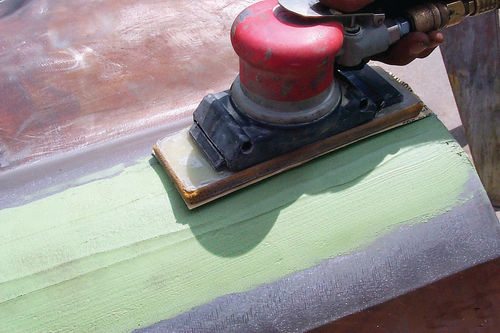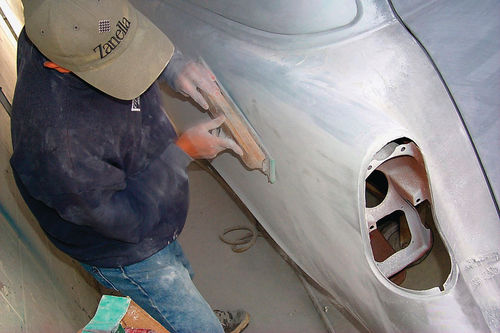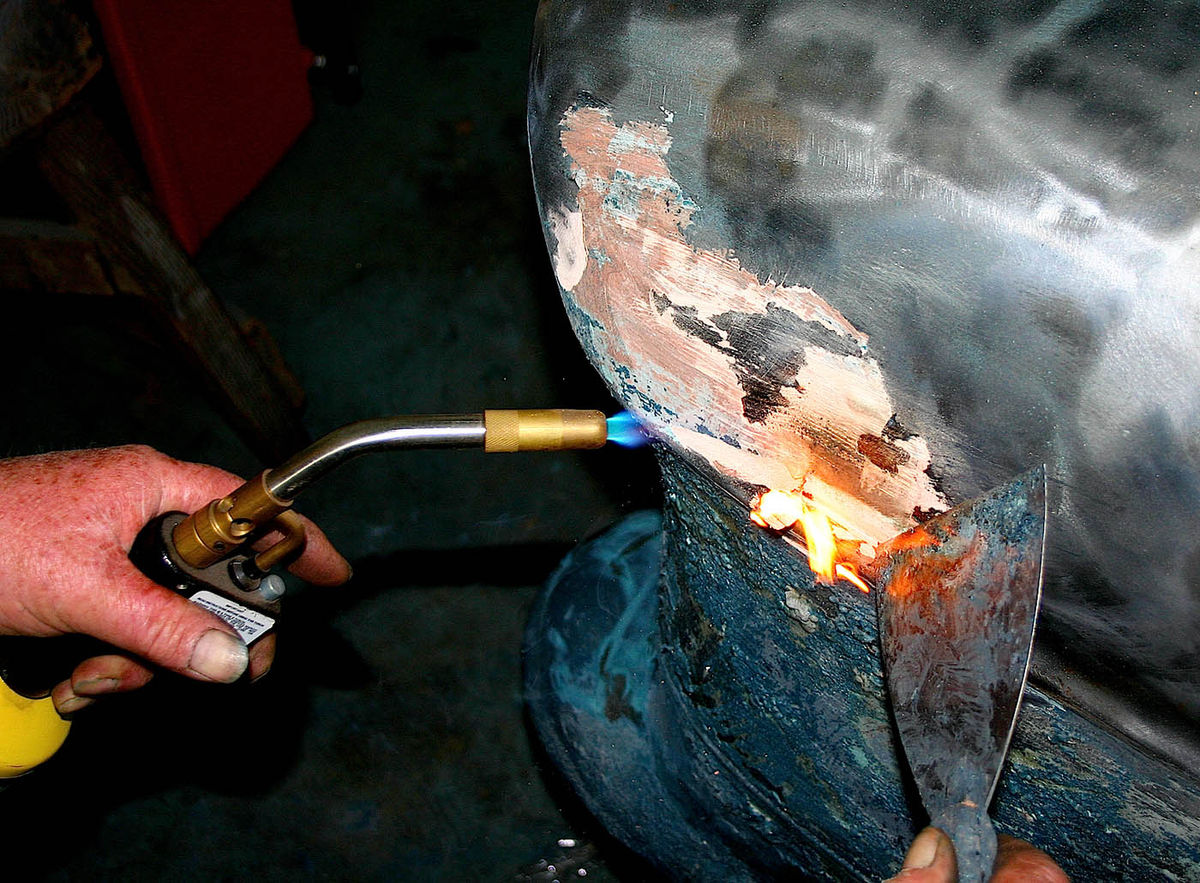Working with plastic body filler
Question:
I am restoring a 1950 Nash Ambassador. I have all of the mechanical work finished, and have started chemically stripping the car for a new paint job that I will have done by a professional. There are no big dents, but as you can imagine, there are a few dings and dimples. An older gentleman next door told me that I should use lead to fill them because of the age of the car. That is way above my skill level as an amateur restorer. Is plastic filler OK for such applications, and if so, how do I go about it?
Answer:
There are a few old school purists in the hobby who would cringe at the thought of using plastic filler (often referred to as Bondo, which is a brand name) to finish a classic for painting. They would point out that lead is all that was ever used on cars before the early ’60s and that it is more flexible and durable than plastic. And they would be right. But how durable and flexible does filler need to be?
Plastic isn’t strong enough to fill holes or patch along sharp edges, or to be used in places that endure a lot of flexing. However, anywhere else— assuming you only use a thin coat and that it is protected from moisture— filler works fine. In fact, plastic fillers work so well that amateurs routinely abuse them.
And most vehicles properly restored with plastic 20 years ago—though driven regularly—still look flawless. The truth is, if you are doing a total restoration on a car during the course of which the body will be stripped to bare metal, you will need to replace all the existing body filler, be it lead or plastic. Both deteriorate over time. Then you will need to decide whether you want to put up with the toxicity, expense and time learning the skills involved in mastering lead just to get that last word in authenticity and durability.
It’s a matter of choice. Lead takes a lot of practice, but you can do it if you try. On the other hand, if you decide—as have most pros— that plastic filler is suitable for your needs, read on. Applying it is fairly easy. But before you get started you will want to pick up a few necessary items at your local automotive paint store.


Things You’ll Need
• Professional-quality plastic filler and catalyst
• Plastic spreaders
• Metal or plastic mixing tray (Never use cardboard. It will absorb critical chemicals and weaken the filler.)
• Cheese grater shaping file
• #80-, #220- #360- grit, open coat, dry sandpaper
• Sanding boards
• Metal prep
• Metal etch or epoxy primer
• Lacquer thinner for washing up.
• Disposable facemask for dust and particulate matter
Neither plastic nor lead were intended to fill deep dents. Professionals only use either filler to smooth minor imperfections. They tap out, shrink and file dents completely if possible. Unfortunately, the less proficient you are as a panel beater, the more you will need to resort to fillers of some kind. If you are a hobbyist working at home, you will very likely need to use a little filler in places, unless your project needs very little work, or you are exceptionally talented.
When you have the dent worked out to where you only need a thin film of filler to make it right, you are ready. Only apply plastic to perfectly clean, bright, metal. After you clean it, wipe the surface down with a metal prep solution. This will etch the metal to give it “tooth” and will remove any silicone that has permeated it as a result of waxes applied to the car over the years.
Before you mix a batch of filler, massage the tube of catalyst to mix it and warm it. Also, stir the filler thoroughly because it separates in storage. Now mix only as much filler as you can easily spread in about 10 minutes. That is usually about a 1/2- inch line of catalyst to a golf ballsized gob of filler, but follow the mixing instructions on the product you purchased. Filler sets up to the consistency of hard cheese in about 20 minutes so more filler will go to waste.
Don’t try extra catalyst or heat to get the material to set up quickly. Worse, don’t try using less catalyst on a hot day either, because you will wind up with a sticky goo that will never harden. Mix the filler and catalyst thoroughly so it has a consistent color throughout. Be careful not to trap air bubbles while mixing because they will cause problems later when shaping.
Apply a thin, even coat of filler about 1 ⁄8" thick to allow for sanding. Keep your spreaders and mixing palette clean, because bits of grit or hardened filler will make grooves in the soft filler as you spread it. And now—while your work is hardening—is a good time to wash up your tools with lacquer thinner. If you neglect them, you will have to chuck them out once the filler hardens.
When the filler sets up to the consistency of hard cheese, shape it roughly with an open body file made for the purpose. Next, switch to #80-grit sandpaper and shape the filler more carefully. Sand in a crisscross fashion to avoid making grooves, and sand well past the edge of the patch. Also, wherever possible, use a sanding board.
Often as not, a second application of filler is required to finish the job. That is the reason why it is important to follow the mixing instructions precisely. If you don’t, your second batch of filler may be harder or softer than the underlying one, which will cause problems when you try sanding it. Pros refer to the result as “a fried egg” because poorly mixed filler shows up in the paint as a bulge within a circle that looks like a fried egg.
Go to #360-grit paper for the final finishing. Use cellulose putty to fill pinholes, but don’t use it for anything else. If you are unsure about whether you have your panel perfectly shaped, shoot on a fine mist of paint in a contrasting color using a spray can, then sand it off with a sanding block. High spots will clean up immediately, but low spots will continue to be speckled after several strokes. Fix any imperfections before going to the next step.
When you have everything right, let the filler cure for several hours in a dry, warm place to allow gasses to escape before priming it. Finally, shoot on a little epoxy or metal etching primer to seal the panel and prevent rust.
















